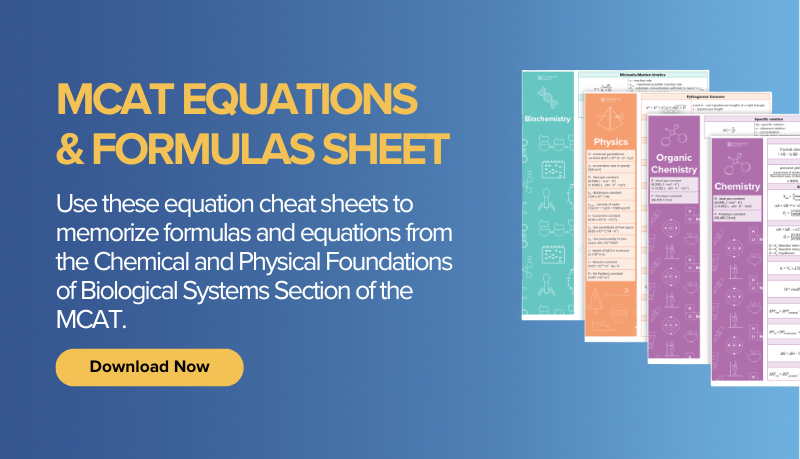
As anyone who is currently prepping for the Medical College Admission Test (MCAT) knows, this isn’t your typical undergraduate exam. The MCAT won’t reward you for memorizing your content and equations. Actually, it expects it. And there are quite a few MCAT equations to memorize.
As an MCAT instructor with years of experience helping students, I’ve seen the difference a solid grasp of foundational equations can make. The MCAT is a daunting challenge. However, with the right preparation and understanding of key concepts, success is possible.
We’ve all heard that the MCAT is a critical thinking exam, first and foremost. Concepts over content. Logical reasoning is everything. Etc.
Therefore, it’s almost impossible to critically think your way to those upper percentile MCAT scores if we don’t have the basics memorized. So, with that in mind, we’ve put together some of the bigger fish in this sea of knowledge that you’ll want to have down pat.
Remember, these equations are not just tools for solving problems; they are the language through which we understand the world around us!
MCAT Equations to Memorize
General Chemistry MCAT Equations
The chemistry section tests your understanding of basic chemical principles and their applications to biological systems. Expect a range of questions from straightforward concept checks to complex problems requiring deep analytical thinking and application of knowledge across several disciplines.
Understanding and memorizing key chemistry equations are crucial for this section. Here’s a comprehensive guide to the essential formulas covering acid-base reactions, thermodynamics, electrochemistry, and kinetics, along with practical tips for mastering these concepts.
Acid-Base Reactions Formulas
Henderson-Hasselbalch Equation: pH = pKa + log([A-]/[HA])
- Application: This equation is fundamental for calculating the pH of buffer solutions and understanding the buffering capacity of blood in physiological conditions.
- Example: Predicting how the blood pH changes in response to metabolic activities.
Concentrations Formulas
Molarity (Concentration of Solution): M = mol / L
- Where M is molarity, mol is the number of moles of solute, and L is the volume of the solution in liters.
Dilution Equation: M1V1 = M2V2
- Where M1 and V1 are the molarity and volume of the initial solution, and M2 and V2 are the molarity and volume of the final solution.
Electrochemistry Formulas
Nernst Equation: E = E° – (RT/nF)ln(Q)
- Application: Calculates the cell potential of an electrochemical cell under non-standard conditions.
- Example: Understanding the electrical potential generated by neurons.
Faraday’s Laws of Electrolysis: Q = nF
- Application: Relates the amount of substance produced at an electrode to the quantity of electricity passed through the electrolyte.
- Example: Calculating the amount of a substance deposited during electrolysis.
Kinetics Formulas
Rate Law: Rate = k[A]^x[B]^y
- Application: Determines the rate of a chemical reaction and how it depends on the concentration of reactants.
- Example: Predicting how quickly a medication will be metabolized.
Arrhenius Equation
- Application: Shows how the rate constant (k) changes with temperature and activation energy.
- Example: Understanding the temperature dependence of enzyme-catalyzed reactions.
Study Strategies and Tips
- Understand, Don’t Just Memorize: Grasp the underlying principles behind each equation. Knowing why an equation is used can often help you remember how it’s used.
- Use Mnemonics: Create memorable phrases or associations to recall complex formulas. Download our free MCAT Mnemonics Handbook for over 50 different MCAT mnemonics.
- Practice with Real-Life Scenarios: Apply these equations to practical situations or problems you might encounter in a healthcare setting.
- Regular Review Sessions: Consistent review helps transfer knowledge from short-term to long-term memory.
- Practice Problems: Work on as many practice questions as you can find. Application reinforces memory and understanding.
- Group Study: Explaining concepts to peers can reinforce your own understanding and uncover any gaps in your knowledge.
Physics MCAT Equations
Physics can be a daunting section of the MCAT. However, with a solid understanding of essential concepts and principles, you can navigate this section with confidence.
Let’s explore the key topics of mechanics, kinematics, thermodynamics, electromagnetism, waves, and optics, and delve into the specific equations that are frequently tested on the MCAT.
Kinematics Formulas
Mechanics deals with the motion of objects and the forces that affect motion, while kinematics focuses on describing motion without considering its causes.
- Relevant Variables: Mass (m), Acceleration (a), Force (F), Velocity (v), Displacement (x), Time (t), gravitational acceleration (g).
Key Equations:
- Kinetic Energy
- KE = 1/2mv^2
- Potential Energy
- U = mgh
- Newton’s Second Law
- F = ma
- Kinematics
- V(final) = V(initial) + at
- V(final)^2 = V(initial)^2 + 2ax
- X = V(initial) + ½ at^2
- X = Vt
Thermodynamics Formulas
Thermodynamics explores the relationships between heat, work, temperature, and energy in a system.
- Relevant Variables: Heat (Q), Work (W), Internal Energy (U), Entropy (S), Enthalpy (H) Temperature (T).
Gibbs Free Energy: ΔG = ΔH – TΔS
- Application: It determines whether a chemical reaction is spontaneous under constant pressure and temperature.
- Example: Estimating the feasibility of biochemical reactions, such as ATP synthesis.
Heat Capacity: q = mcΔT
- Application: Used to calculate the heat absorbed or released during temperature changes.
- Example: Determining the amount of heat required to increase the temperature of a solution in a calorimeter.
Ideal Gas Law: PV = nRT
- Where P is pressure, V is volume, n is the number of moles, R is the ideal gas constant, and T is temperature in Kelvin.
Electromagnetism Formulas
Electromagnetism encompasses the study of electric and magnetic fields and their interactions with matter.
Relevant Variables: Electric Current (I), Voltage (V), Resistance (R), Power (P), Magnetic Field (B).
Key Equations:
- Ohm’s Law,
- V = IR
- Relates voltage, current, and resistance in an electrical circuit. The power equation, (P = IV), connects power with current and voltage, indicating the rate at which electrical energy is converted into other forms.
Waves and Optics Formulas
This topic covers the behavior of waves and light, including reflection, refraction, and diffraction.
Relevant Variables: Frequency (f), Wavelength ((\lambda)), Speed of Light (c), Energy (E).
The Planck-Einstein relation
- E = hf
- Links the energy of a photon to its frequency, with (h) being Planck’s constant. This equation is foundational in understanding light’s particle-like behavior.
Relevant Variables: focal length (f), image distance (di), object distance (do)
Thin Lens Equation
- (1/f) = (1/di) + (1/do)
- Describes the relationship between a lens’ focal length, image distance, and object distance, and can be used to calculate the image distance for either real or virtual images and for either positive on negative lenses.
Connecting the Equations
Many of these equations are interrelated. For instance, the work-energy principle in mechanics ((W = Δ KE)) can be connected to the first law of thermodynamics by considering kinetic energy as a form of internal energy. Similarly, the thin lens equation and the magnification equation are directly related through their shared variables.
Study Tips and Resources
- Conceptual Understanding: Start with a strong grasp of the concepts before memorizing equations. Understanding the underlying principles makes it easier to apply equations in various contexts.
- Flashcards: Create flashcards for each equation, including variables and units. Regular review helps reinforce memory. Access 1600+ free MCAT flashcards curated by Blueprint MCAT experts.
- Practice Problems: Apply equations to practice problems, especially those that integrate multiple concepts. This will enhance your problem-solving skills and deepen your understanding.
- Group Study: Discussing problems with peers can provide new insights and clarification of difficult concepts.
- Equation Sheets: Now that you have a better understanding of the MCAT equations to memorize, create an equation sheet that you can quickly review. Regularly test yourself on these equations and their applications. Get a free one created by Blueprint MCAT experts here.
Biology MCAT Equations
The MCAT Biology section encompasses a wide range of topics, from the molecular level in biochemistry to the systemic organization in anatomy and physiology. Biology is often more conceptual. However, certain quantitative aspects require a grasp of specific equations.
Here’s a breakdown of essential equations across various biology topics, along with tips for memorization and application.
Cell Biology
Osmotic Pressure Equation: (π = iMRT)
- Function: Calculates the osmotic pressure ((\Pi)) of a solution, where (i) is the van ‘t Hoff factor, (M) is molarity, (R) is the ideal gas constant, and (T) is temperature in Kelvin.
- Application: Understanding how solute concentration affects water movement across cell membranes.
- Memorization Tip: Think of “iMRT” as “I’m Right There” to remember the variables.
- Contextual Question: How does the osmotic pressure change if the molarity of the solution inside a cell increases?
Genetics Equations
Hardy-Weinberg Equilibrium Equation: (p^2 + 2pq + q^2 = 1)
- Function: Used to calculate allele frequencies in a population, where (p) and (q) represent the frequency of the dominant and recessive alleles, respectively.
- Application: Predicting genetic diversity and evolution patterns in populations.
- Memorization Tip: Associate “p” and “q” with “parents” and “quitters” to distinguish between dominant and recessive.
- Contextual Question: What happens to allele frequencies if a population is not in Hardy-Weinberg equilibrium?
Biochemistry Equations
Michaelis-Menten Equation for Enzyme Kinetics:
- Function: Describes how the reaction velocity (v) depends on substrate concentration [S] for enzyme-catalyzed reactions.
- Application: Analyzing enzyme efficiency and inhibition.
- Memorization Tip: Visualize an enzyme (E) reaching its maximum speed (Vmax) on a highway as the substrate (S) concentration increases.
- Contextual Question: How does the addition of a competitive inhibitor affect V(max) and the Michaelis constant (Km)?
Anatomy and Physiology Equations
Cardiac Output Equation:
- Function: Determines cardiac output (CO), CO = cardiac output, VO2 = oxygen consumption in ml of pure gaseous oxygen per minute, Ca = oxygen content of arterial blood, and Cv = oxygen content of mixed venous blood
- Application: Assessing heart function and blood flow.
- Memorization Tip: Remember “CO” as “Company,” and that the company’s output depends on the rate (HR) and volume (SV) of its operations.
- Contextual Question: What is the effect of increased heart rate on cardiac output, assuming stroke volume remains constant?
Study Strategies for Memorization and Application
- Analogies and Mnemonics: Create vivid associations or silly mnemonics to make abstract concepts more tangible.
- Practice Questions: Regularly test yourself with practice questions that apply these equations to real-world scenarios. This not only helps with memorization but also with understanding their applications.
- Flashcards: Use flashcards for quick, repetitive review of equations and their meanings.
- Group Study: Explaining concepts to peers can reinforce your own understanding and reveal new insights.
Final Thoughts
Understanding when and how to these MCAT equations to memorize is a crucial step in your MCAT preparation. Practice applying these equations to a variety of problems and you’ll develop a deeper comprehension of the concepts they represent.
Remember, the MCAT doesn’t just test your ability to recall information—it assesses your capacity to think critically and apply your knowledge in novel situations.
In your study sessions, focus on memorization and problem-solving. Work through practice questions and full-length exams to become comfortable with the format of the MCAT and fine-tune your strategy.
Finally, if you need any help, don’t hesitate to reach out to us! Blueprint MCAT students increase their MCAT scores by 15 points, on average.
Whether you need the flexibility of a Self-Paced Course, the instruction of a Live Course, or 1:1 attention of a private MCAT tutor, we have the MCAT prep option that works for your learning style!
Ready to start on the path toward your MCAT score increase? Get access to tons of free MCAT resources today when you create a free Blueprint MCAT account!
Search the Blog

Free Consultation
Interested in our Online MCAT Course, One-on-One MCAT Tutoring or Med admissions packages? Set up a free consultation with one of our experienced Senior Student Advisors.
Schedule NowPopular Posts
-
MCAT Blog What's on the MCAT?
-
MCAT Blog How to Review MCAT Full Lengths

Free MCAT Practice Account
Need great MCAT practice?Get the most representative MCAT practice possible when you sign up for our free MCAT Account, which includes a half-length diagnostic exam and one of our full-length MCAT practice exams.
Learn More








